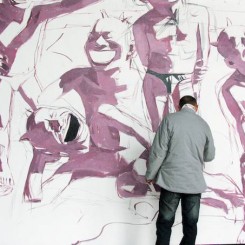“L’Ombre du Fou Rire” (Nov 14, 2012 — Mar 13, 2013) is a survey of the work of Yue Minjun currently on show at the Fondation Cartier in Paris. Through 40+ paintings spanning his oeuvre from its early stages to the present, audiences may witness Yue’s artistic practice — its grimacing faces a favorite image in the media and market — at first hand. Randian editor Iona Whittaker met Yue Minjun at his Beijing studio to discuss the exhibition and his work in general.
Iona Whittaker: Tell me about this exhibition at the Fondation Cartier. How did it come about and what has been the process of its creation?
Yue Minjun: The process began in 2008. Fei Dawei contacted me, saying that the Cartier Foundation wanted to have an exhibition — a new one, or perhaps a retrospective. A lot of people have already seen the works, for example in the media or in books and magazines, but have never seen the originals. I feel it’s worthwhile to have the opportunity to present the real works to them at first hand. At that time, I also thought about making some new works, but I felt that if I did so, maybe it would be too much like “performing” to attract the audience. So I adopted the opposite approach: I avoided having any involvement in or opinion on the selection and arrangement of the exhibition. I left the curator to present the works in their own way. Just before the opening of the exhibition, I spoke to the curator; I asked him, “Why are you interested in my work, and from which point of view?” He answered that he had no idea, and that it was as if as I had been watching them.
IW: What do you mean by not wanting to “perform” to the audience by including new work?
YM: If I were to have created new work for the exhibition, it’s sort of as if there is a single purpose for it. I just wanted to show the natural progression of my work. The latest painting in the exhibition is from this year, but that was simply down to the curator’s selection, not my having asked for it to be included.
IW: So, what is your reaction to the works that were chosen? Were your expectations confirmed? Did anything surprise you?
YM: I feel that it’s a very simple way to display the work. The placement of the paintings in the space does not conjure any sort of mystery or imposed reading. It is largely chronological and straightforward.
IW: It’s very trusting of you to let the curator take total control. Did you have any doubts about it?
YM: I deliberately had no expectations about it. I really wanted to perceive a different understanding and cultural background as reflected through the choices made. I feel happy because they didn’t impose anything beyond the actual content of the work — it is an honest and sensitive presentation.
IW: And how many works are in the exhibition?
YM: More than forty — forty-seven? — I forget (laughs).
IW: You don’t often have such large-scale exhibitions. From your point of view, what is the effect of seeing all these works together — this “image” of your practice? Does this throw up new impressions for you, or provoke thinking about what you are currently working on, for example?
YM: Many of the works I haven’t seen for perhaps 10 or 20 years, so when I see them together for the first time in the exhibition, there are a lot of feelings. I never felt I was an artist who is focused on technique, but I perceive a kind of honesty and simplicity when I see these works again. My feeling is different from before; I can judge the work more objectively. And for the future, these feelings focus my interest in painting on canvas. I still feel that this is the most appropriate medium for addressing the essential problems of art and of expression.
IW: We are beginning to see solo retrospective exhibitions in China now. Are you keen to have one of your own? What would that mean to you personally?
YM: I haven’t been preparing for this. Some artists began preparing years ago for their own retrospective, gathering works. But for me it’s difficult because I don’t have the work. I felt early on that if the works have their own value for history, they will be shown — that is, if people perceive value in them, they will show them in their own way. So for its own sake it is not important to have a retrospective; it is really down to the judgement of others. If they feel the work is worth showing, they will show it. As such, a retrospective of my work could happen if I was invited to do so, not “on purpose,” as it were.
IW: You are internationally recognized as the originator of one of the most famous images of the late-20th Century. On reflection and in hindsight, how would you describe your original ambition as an artist?
YM: At first, I was not clear what kind of image I wanted to create, but through working, I discovered what had value for me, and then I found completion.



